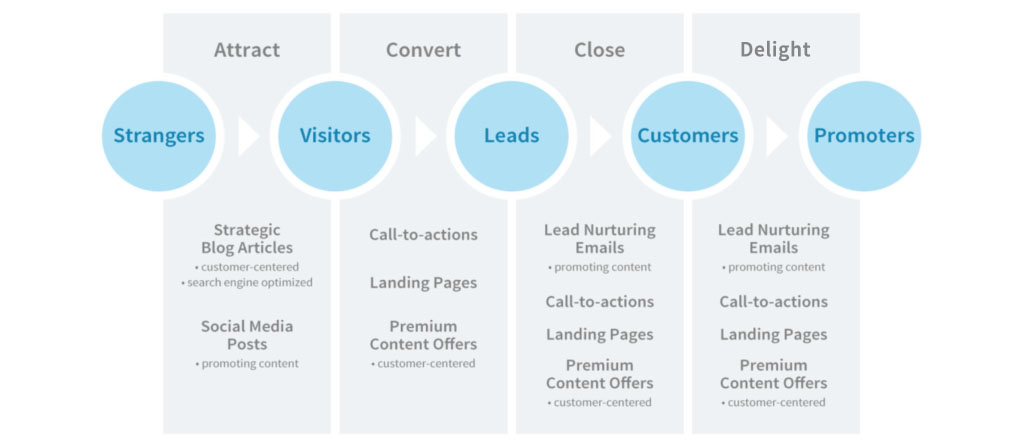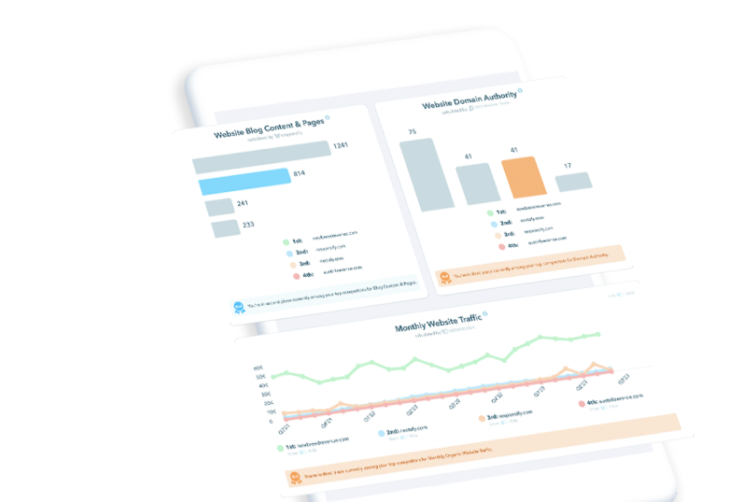 3450 Views
3450 Views  4 min read
4 min readThe inbound methodology stages offer a customer-centric alternative to traditional outbound marketing. This effective framework utilizes four integrated stages to convert individuals into enthusiastic brand advocates. The Attract stage focuses on drawing the appropriate audience to your website using valuable content and SEO. Next, Convert transforms these visitors into leads by obtaining their contact information for relevant resources. The Close stage involves nurturing qualified leads with personalized communication until they become paying customers. Finally, Delight ensures ongoing value delivery, turning customers into loyal promoters who recommend your business. By aligning marketing, sales, and service efforts with this methodology, businesses can establish a sustainable growth engine that enhances customer acquisition and cultivates enduring relationships for long-term success.
This approach is a modern take on marketing. In the past, Outbound Marketing was used by most marketing professionals. Why? Because Outbound Marketing has been around forever, with print ads, television commercials, and radio. This form of marketing is a more generalized take on marketing, attempting to reach the masses, which leads to very few leads most of the time. The issue with Outbound Marketing is that everyone you are marketing to is generally not interested in your product. This creates more issues for marketing professionals making it harder to get in front of your potential customer.
But enough about Outbound, let’s talk Inbound! In this article, we’ll go over Inbound Marketing and the Inbound Methodology Stages that apply.

To effectively market a service or product, marketing professionals must focus on attracting the right audience, rather than marketing broadly to the masses. Targeting the correct individuals whose needs align with your offerings prevents your outreach from being perceived as spam. Indirectly build awareness of your service and highlight its benefits by utilizing buyer personas.
Providing high-quality, relevant content is the most effective way to attract your target audience through platforms such as opt-in email, blogs, and social media. To further enhance reach, optimize your content with specific keywords that match what your ideal customers are searching for. This process, known as Search Engine Optimization (SEO), is essential for digital marketing, ensuring your content appears as a top result.
Now that we attracted the ideal audience, what’s next?
After your ideal customer engages with your valuable content, it’s time for an exchange. This can involve landing pages, call-to-action, and contact tracking. Beyond your excellent content, aim to leave your audience with and additional benefit. By offering this value, you can request their contact information in return, generating a potential lead. The purpose of this stage is to convert your audience into potential leads, building trust and moving you closer to your objectives. Call to actions can include offering free eBooks and guides. Your audience typically needs to provide information such as name and email to access these items.
Closing the deal, a critical stage, transforms qualified leads into paying customers. While generating numerous leads is important, focusing on the most promising ones is key. Your objective is to convert these potential customers through various strategies, including lead nurturing, lead scoring, and offering targeted promotions. This can be accomplished through direct interaction or your website. The ability to close a deal determines success. Since potential customers aren’t always ready to purchase immediately, lead nurturing is essential. This involves delivering the appropriate content to the right customer profile.
The delight stage, often neglected, is crucial for turning paying customers into loyal advocates. Ensuring customers have a positive experience with your product or service fosters trust and encourages positive word-of-mouth referrals, a powerful marketing tool.
Beyond referrals, customer retention is paramount. Focusing solely on the initial sale overlooks the significant potential for repeat business. Gathering customer feedback is essential for ensuring satisfaction. Utilize surveys via email, phone, or in-person to understand customer sentiment. This valuable insight allows you to improve your offerings and adapt to consumer needs. Social media also provides a significant avenue for gauging customer happiness. By prioritizing customer delight, you cultivate loyalty and unlock opportunities for sustained growth.
Also Read – Inbound Marketing Tools to Effectively Generate Leads
Marketing involves a lot of process and attention to detail. In the past, majority of businesses would market toward the masses, but that does not work anymore. Creating buyer personas and targeting the correct audience is key to becoming a successful marketer.
Content marketing has been on the rise and does not seem to be slowing down anytime soon. When consumers are researching for potential help to their need, you want to be the one front and center providing quality content so that your reader will walk away happy and interested in more.
Content marketing with SEO is a viable solution to helping you receive the quality leads you are looking for. Remember, it’s not about how many leads you have, it’s about the quality of your leads.
Responsify is an all-in-one content and inbound service provider. We create a scalable strategy from the 4 Inbound methodology stages and help produce quality content through SEO to help you gain the quality leads you want. For a typical business to pursue Inbound marketing, they typically need to hire a writer, editor, strategist, and social expert for starters. Responsify takes away the burden of hiring a full-stacked team and is here to make a difference for your business To learn more about content marketing and how Responsify can help you attain your goals, feel free to reach out for a 1-on-1 strategy session today! We hope you enjoyed learning more about Inbound Methodology Stages, and are here to help.
Also Read – Best Ways to Develop an Effective Content Inbound Marketing Strategy
Use SEO, keyword-optimized blog content, social media engagement, and thought leadership to bring your target audience to your website organically.
Offer valuable resources (like eBooks, templates, or webinars) in exchange for contact information. Use clear CTAs, forms, and landing pages to facilitate the conversion process.
CRM systems (like HubSpot or Salesforce), lead scoring, email workflows, and sales alignment tools help guide qualified leads through the sales funnel efficiently.
Delighting customers through great service, helpful content, personalized follow-ups, and proactive support encourages them to stay loyal, refer others, and become brand promoters.
Yes, by aligning marketing and sales and using data-driven strategies, inbound can accelerate lead nurturing and shorten sales cycles—especially with marketing automation and targeted content.
Start with clear buyer personas, map out the customer journey, prioritize quick-win content for each stage, and use marketing automation tools to streamline your efforts. Partnering with an experienced inbound agency can also fast-track results.
